This Special Report on Blockchain is available as PDF download below.
For some people, the blockchain boom is just a case of old wine in new bottles, while others anticipate disruptive applications. What is beyond doubt is that blockchain is able to solve many tasks very elegantly. Moreover, it is generally available thanks to cloud computing and frameworks. Because the blockchain method promises very high security for information exchange, it is ideally suited for B2B scenarios and specifically for ERP environments. SAP partner Camelot was one of the first companies in the community to engage with blockchain at a deeper level, and today it is a leader in this area. E-3 Editor in Chief Peter M. Faerbinger spoke to Josef Packowski, CEO of Camelot Consulting Group, and Steffen Joswig, Managing Partner of Camelot Innovative Technologies Lab (Camelot ITLab).
In the past few years, blockchain has attracted more attention than almost any other technology. Inspired by the soaring success of cryptocurrencies, more and more sectors beyond the financial industry are investigating the application possibilities of this highly encrypted, and thus secure, distributed database technology. Blockchain is a database system that is distributed over many nodes in a network. Strong cryptography protects it against manipulation. The “network,” in which the data is present in concatenated and encrypted form, has a further advantage: A data transaction can take place without an intermediary – and is counterfeit-proof, too! Blockchain could change the way in which market participants in various sectors conduct transactions with each other – turning whole branches of industry inside out in the process. In industries such as logistics and manufacturing or the energy sector, numerous companies are exploring application possibilities: everything from direct electricity trading between neighbors to transparent, traceable supply chains.
The technology
The possibilities of blockchain technology offer an ideal basis for large networks with many different partners. They work like a shared ledger in which all the transactions that take place inside the network can be recorded in a shared, unalterable manner. In addition, they give duly authorized partners access to the confidential data in real time. With the use of this technology, a completely new system of instructions and authorizations can be introduced into the information flow. It allows the different trading partners to obtain a shared view of the transaction which has been agreed by all the parties – one in which, moreover, confidentiality and data protection are guaranteed.
Is it possible to describe the technology in a nutshell? “An adequate explanation needs a bit more space, I’m afraid,” replies Steffen Joswig. “Blockchain is essentially a concatenated list in which every list entry (block) can comprise one or more data sets. The concatenation is realized through cryptographic fingerprints known as hash entries. Each hash entry is created out of all data sets of a list entry. The hash entry is included in both the previous and the subsequent list entry. Consequently, list entries are unalterably linked together, like a chain.”
Smart contracts
Furthermore, blockchain is a fully redundant data repository. All participants in a network possess all data, which is constantly synchronized. “However, the true essence of blockchain is the programmability of the network via smart contracts,” emphasizes the Managing Partner of Camelot Innovative Technologies Lab. A smart contract is a small program that is installed in the blockchain and kept there – just like other data – in a redundant, unalterable manner. Through the interplay of smart contracts, data and predefined events certain processes can be modeled in a counterfeit-proof and trustworthy way without the need for the middlemen that have been necessary before
To give an example: IBM and Maersk, world leaders in container logistics, launched a collaboration in June 2016 to jointly develop new blockchain- and cloud-based technologies. These are designed to help companies track the route their goods take across international borders. This would benefit manufacturers, shipping and transportation companies, ports, terminals, and customs agencies.
Blockchain is not the same thing as Bitcoin
“Bitcoin was the first implementation of a blockchain – and has even caught the attention of the world’s media on account of the speculation hype,” explains Josef Packowski, CEO of the Camelot Consulting Group. “However, this ignores that blockchain is just one of many elements in the Bitcoin architecture. We always stress that blockchain is not the same thing as Bitcoin.”
Is the technology a fashion trend, then, or a megatrend, because confidential communication and data exchange will no longer be possible without blockchain? “Confidential communication and data exchange are possible even without blockchain,” emphasizes Packowski. “That alone does not make blockchain a megatrend. Although concepts such as asymmetric encryption are an inherent part of blockchain, it should not be reduced to them alone. The full potential of the technology will only be realized when a blockchain network is used as a “trust machine” that removes the need for middlemen.”
Drawing on his experience in initial projects, Steffen Joswig adds: “To implement something like this, however, all blockchain concepts – the guaranteed authenticity of all participants, decentralization, the immutability of data, and secure program flows (smart contracts) – must be deployed in equal measure. Regarding this field of application, blockchain is indeed a megatrend, and one that will soon be indispensable.” From the perspective of an existing SAP customer: For which applications could the use of blockchain work based on ECC 6.0 and S/4?
“In the context of SAP systems going forward, we see side-by-side add-ons to existing SAP modules as a starting point,” explains Steffen Joswig. “From case to case, we must now discuss which data from the SAP system can be usefully associated with blockchain.”
Without experienced partners such as Camelot, projects like this are scarcely practicable, as they require a lot of business and technical know-how: As a rule, no data is stored redundantly on the blockchain, rather it is registered there via a cryptographic hash. This approach ensures that you cannot alter the associated data in the SAP system unnoticed. In this way, you could implement track & trace scenarios secured by blockchain in the SAP-SCM environment or create inter-company transport marketplaces in SAP TM.
“But these use cases generally only use individual blockchain features such as immutable history,” notes Steffen Joswig. “More interesting are use cases in which the blockchain functions as a trust machine mediating between several parties. In this case, the SAP system and its database act merely as a so-called off-chain persistence, as the application logic generally has to take place in the abovementioned smart contracts whenever trust is not fully present.”
In addition to the new business processes, another important question for existing SAP customers is naturally the infrastructure and the hardware requirements. “That depends on the selected deployment method, which in turn strongly depends on the use case,” reckons Josef Packowski, before handing over to his colleague Steffen Joswig: “Publicly accessible blockchains are the most hardware-intensive, because they use a computing-intensive proof algorithm, such as with Bitcoin and Ethereum. For consortium blockchains with a clearly defined set of participants, however, a small Linux VM per node is sufficient, with manageable resources per blockchain node.”
“We ourselves do not offer any blockchain of our own,” adds Josef Packowski. “There are very many technologies on the market. But using them generally turns out to be very complex in practice. We’ve taken all our accumulated experience with blockchain technologies and put it into our Camelot Hypertrust Platform.”
Camelot has invested a lot of resources into its work on blockchain technology, and this benefits the SAP community today. “At the beginning of our research in this area, we decided that we would not simply document it, but invest in a reusable framework,” explains Joswig. “Using the framework, we can develop individual use cases for customers in double-quick time. In customer projects, we then supplemented our framework with requirements from real-life use cases.”
Setting up and operating ordinary blockchains is a complicated business. “Without spending dreary hours inputting commands in command lines, you cannot begin with the development of distributed applications,” says Steffen Joswig, who knows the truth of this all too well from his operational environment. But at Camelot, they asked the questions: How can we simplify this process? How can we reduce the implementation costs in blockchain projects? How can we empower customers even without development staff to experiment with the technology? These questions gave birth to the Camelot Hypertrust Platform.
“It is difficult to use a raw blockchain directly for application development,” emphasizes Josef Packowski. That would be like a database without an application server, explains his colleague Steffen Joswig: “For us, the middleware serves as a link between the blockchain, a user interface based on SAP-UI5, and further services, such as Web services from the SAP Leonardo portfolio – IoT, AI, etc. – and also as a container for our blockchain applications. These consist partly of smart contracts and of chain code inside the blockchain and server-side Java scripts outside the blockchain.” Another question also arises: private or public blockchain? “Depends on the use case,” says Josef Packowski. “But within the context of value chains, we’re usually talking about consortium blockchains – a private network with a clearly defined group of participants. Completely private blockchains are generally only needed for development.”
Through initiatives such as those pioneered by Camelot and SAP Leonardo, the topic has definitively arrived in the SAP community. “Our customers and partners want to work with us and employ blockchain as a decentralized transaction register to improve cooperation and transparency,” says Tanja Rueckert, President IoT & Digital Supply Chain at SAP, who will become President of Bosch Building Technologies on August 1st, 2018. “The goal is a future in which blockchain is an integral part of the digital value chain.” At SAP, for example, the Advanced Track and Trace for Pharmaceuticals pilot project was created, which can help pharmaceutical companies comply with the legal requirements for protection against counterfeit drugs.
Through joint innovation with customers and partners, SAP wants to create use cases for blockchain that can be employed in a standardized manner and on a broad basis – in logistics and in SAP Leonardo IoT solutions. “What’s interesting is that similar architectures quickly emerged here,” says Josef Packowski. The Camelot Hypertrust Platform was unveiled to customers in the first quarter of 2017 (then still called the Camelot Hypertrust Network).
“Then when we saw the first beta version of the SAP Cloud Platform Blockchain Service at the end of the second quarter, we were taken aback by the similarity of the two stacks,” recalls Packowski. “Many of the components used are common to both. Through the deployment model, however, the two offers differ quite clearly: SAP Cloud Platform Blockchain Service is only available in the cloud, whereas the Camelot Hypertrust Platform can fill on-premise “blank space” in a SAP context, but in principle can also be operated in the cloud.” Steffen Joswig explains further: “At first glance it seems abstruse with blockchain, which is designed to eliminate the need for trustworthy third parties, to rely on trustworthy third parties – cloud providers. But the fact is that these are software and hardware services which also have their justification. The provision of ready-made frameworks to simplify the implementation of blockchain networks – whether that be in the cloud or on the customer’s premises – is a genuine added value for business.”
What the community needs is a good mix. SAP customers will value the SAP Cloud Platform Blockchain Service because of its simplicity, but they must take care not to exclude their business partners and any non-SAP customers.
“In addition to our consulting and technology portfolios, our services include many training offers and workshops,” stresses Josef Packowski, because he is aware of the knowledge deficit that exists in the SAP community. “From executive briefing workshops to developer and administrator training courses, we offer the right program for every company level to enable businesses to understand blockchains, evaluate their potential, and be able to use them.”
Finally, Josef Packowski emphasizes the close cooperation between Camelot and SAP: “We’re partners of SAP in the Blockchain and IoT Co-Innovation Program.” Blockchain has definitively arrived in the SAP community!




















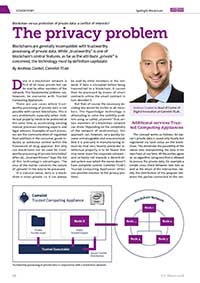
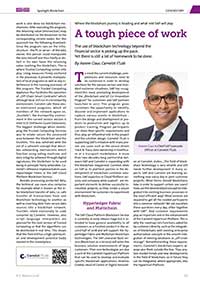


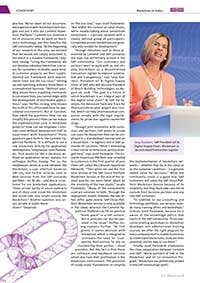
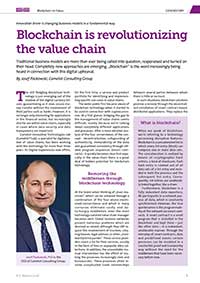
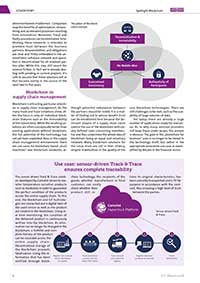
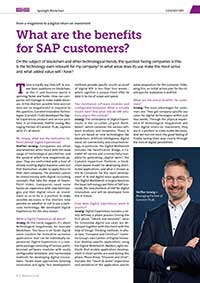
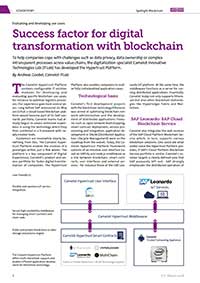




Add Comment